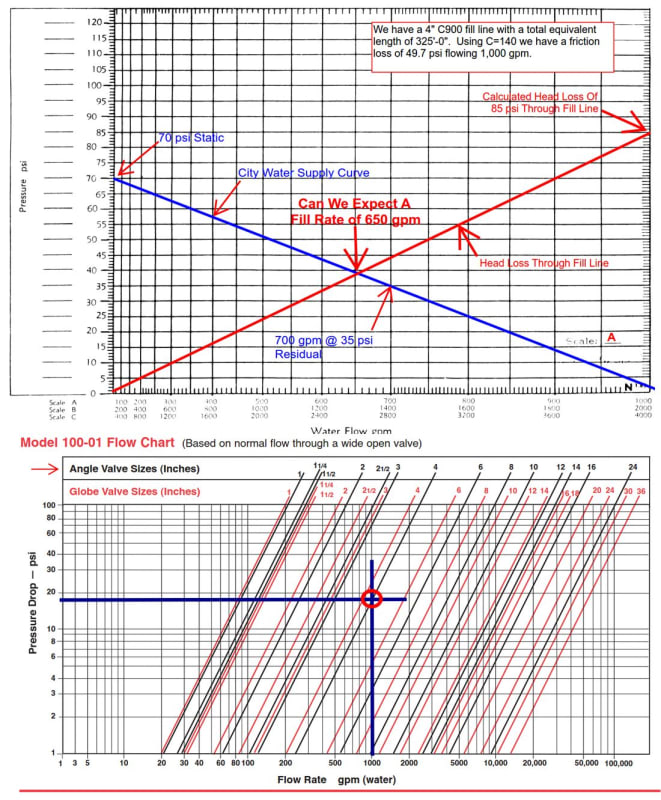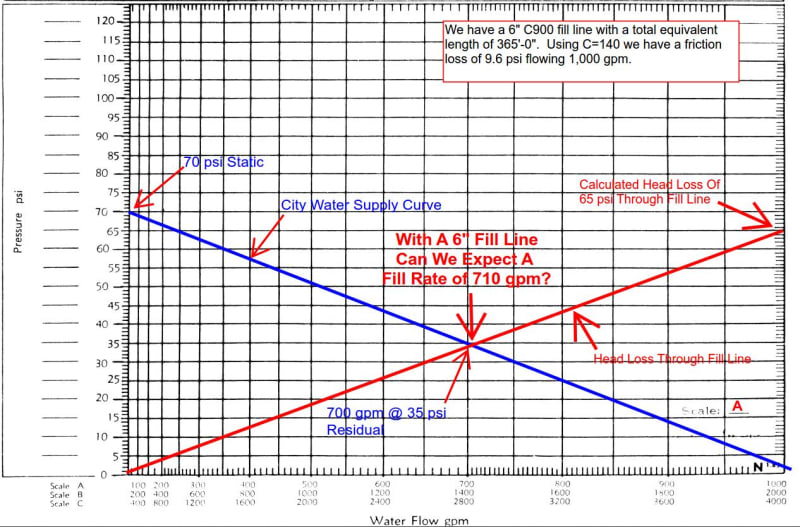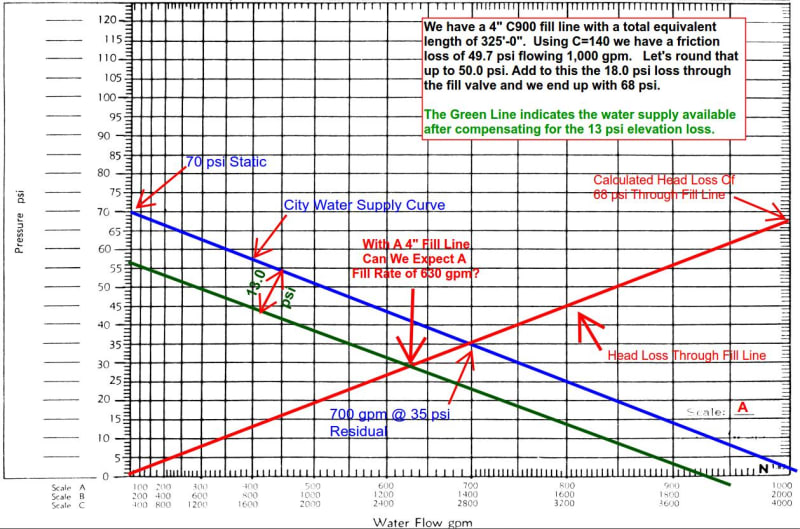SprinklerDesigner2
Mechanical
In 45 years I have yet to have a project where I would have to have a ground storage tank because where I am, south Georgia swamp land, I've always gone with a vertical turbine pump out of a pond. Travis, where I am if you did a hole it will fill with water.
I have a storage facility that requires 1,704 gpm for 60 minutes.
City water supply is 70 psi static, 35 psi residual flowing 700 gpm.
It's obvious I will need a tank and fire pump but what size tank? The easy answer is 1,704*60=102,240 gallons.
With steel tanks running $1.50 or more a gallon I would like to use an automatic fill valve so I can install a smaller tank.
Let's look at the CLA-VAL Model 100-01 automatic fill valve.
[URL unfurl="true"]https://www.cla-valpacific.com/documents/pdf/E-100-01.pdf[/url]
I want to install a 4” C900 4” fill line which has a total equivalent length of 325' which, when using C=140, will give us a friction loss of 49.7 psi when flowing 1,000 gpm.
I know, NFPA tells C=150 for C900 but I want to error on the side of caution so I'll use 140.
When the tank is full the water level is 30'-0” so I need to add another 30*.433=13.0 psi to the 49.7 psi which brings me to 62.7 psi. Using the Model 100-01 Flow Chart it appears the pressure drop through the valve will be 18 psi flowing 1,000 gpm so I have to add that 18 psi to the 62.7 psi giving us a total loss of 80.7 psi so just to be on the safe side let's call it 85 psi @ 1,000 gpm just to be a little more on the safe side.
I am going to graph this on the ^1.85 graph paper
Do you agree that I could expect an automatic fill rate of 650 gpm when the tank is full or am I all wet?
At an automatic fill rate of 650 gpm I can reduce the size of the tank to from 102,240 gallons by 650*60=39,000 gallons to 63,240 gallons? Would I be safe with a 65,000 gallon tank?

I have a storage facility that requires 1,704 gpm for 60 minutes.
City water supply is 70 psi static, 35 psi residual flowing 700 gpm.
It's obvious I will need a tank and fire pump but what size tank? The easy answer is 1,704*60=102,240 gallons.
With steel tanks running $1.50 or more a gallon I would like to use an automatic fill valve so I can install a smaller tank.
Let's look at the CLA-VAL Model 100-01 automatic fill valve.
[URL unfurl="true"]https://www.cla-valpacific.com/documents/pdf/E-100-01.pdf[/url]
I want to install a 4” C900 4” fill line which has a total equivalent length of 325' which, when using C=140, will give us a friction loss of 49.7 psi when flowing 1,000 gpm.
I know, NFPA tells C=150 for C900 but I want to error on the side of caution so I'll use 140.
When the tank is full the water level is 30'-0” so I need to add another 30*.433=13.0 psi to the 49.7 psi which brings me to 62.7 psi. Using the Model 100-01 Flow Chart it appears the pressure drop through the valve will be 18 psi flowing 1,000 gpm so I have to add that 18 psi to the 62.7 psi giving us a total loss of 80.7 psi so just to be on the safe side let's call it 85 psi @ 1,000 gpm just to be a little more on the safe side.
I am going to graph this on the ^1.85 graph paper
Do you agree that I could expect an automatic fill rate of 650 gpm when the tank is full or am I all wet?
At an automatic fill rate of 650 gpm I can reduce the size of the tank to from 102,240 gallons by 650*60=39,000 gallons to 63,240 gallons? Would I be safe with a 65,000 gallon tank?



